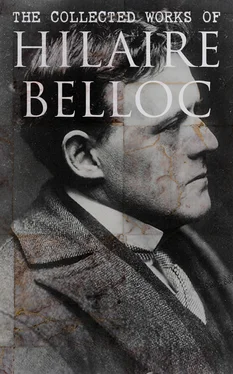This was the end of the Battle of Crécy, in the night of Saturday the 26th of August, 1346.
Early upon the Sunday morning, Edward’s forces stood to arms again, not knowing whether even yet a new attack might not be made. Mist covered all the landscape, through which fog, dimly, bodies of men seemed to be advancing upon them from the south. They were reinforcements of Philip’s come up in ignorance of what had passed the day before, or at any rate not appreciating how decisive the day had been. Five hundred knights riding out easily dispersed them. Further bodies straggling up in similar fashion were dealt with in detail, and all that morning the English soldiers going at large over the fields found and put to the sword lost fragments of militia, came, as they tracked the flight, upon dead and wounded lords, and cut off bewildered remnants, making they knew not whither over the land.
The total French losses will never be known. The legend of disaster calls them now ten, now twenty thousand. Of the mounted and armoured men of rank the heralds made a precise account, and returned a list to King Edward of 1542 fallen and dead upon the front of the battle and in the first fields of the retreat. To these due sepulchre was given. The mass of the fallen were buried in common trenches, marks of which may be seen to this day; and it is said that fires were lit to rid the ground of the dead.
The English loss was wholly insignificant. Its exact amount, like that of its enemy, we cannot tell, because a list of but two knights, one squire, and forty of the rest, not counting a few Welsh, is all that we are given. But, even if this total (which hardly corresponds to the fierce mêlée at the beginning of the action on the right) be below the true number, we may be certain that that number was very small indeed. The line was never pierced; the English fight was wholly defensive, and a defensive maintained at range against troops which disposed, after the first rout of the Genoese, of no missiles upon their side.
Upon the Monday morning, the 28th of August, the host set forth upon its northern march, quite free now from any danger of pursuit. By the first days of September it had sat down before Calais. All winter and all the succeeding summer the blockade continued, and upon the 4th of August 1347, nearly a year after Crécy, the town was taken and the lasting fruit of that engagement was garnered. Calais remained an English bastion upon the Continent for more than two hundred years.
1.We have this upon the evidence of a contemporary, Villani. It has, of course, been denied by our modern academic authorities, but without evidence.
2.The theatrical character which attaches to warfare through the fourteenth century appears at this very outset of the campaign. Edward knighted the Black Prince and sundry other commanders on a hill overlooking the fleet and the harbour just before the main body disembarked. The Black Prince had already been knighted, and the ceremony was mere parade.
3.He did not go to Rouen, or near it, as the map in Mr. Fortescue’s work (vol. i. p. 37) presumes. Rouen was, he found, too strongly held. There is no time for the big loop of twenty miles which Mr. Fortescue introduces, and no evidence for it.
4.This is not N. D. de Vaudreuil, as Professor Thompson suggests, but St. Cyr just beyond where the bridge is.
5.This point has also proved puzzling. Thus Professor Thompson calls it “difficult to find.” What the clerk heard and set down was the peasants’ term “L’Angreville.”
6.This, as Professor Thompson rightly says, is not on the modern maps. It stood just above Nezel near the modern Chateau between that village and Falaise or “The Cliff.”
7.So I read the meaningless rigmarole of the Clerk of the Kitchen. But I may be wrong. Professor Thompson inclines to Ecquevilly, a mile or two further on.
8.Or six , if we read Ecquevilly. The main army halted at Flins.
9.The low tide after the full moon occurred on that 24th of August at about half past-six o’clock in the open sea and nearer eight o’clock in the estuary, or even later; for we must allow quite seven hours’ ebb to five hours’ flow in that funnel in its old unreclaimed state.
10. Antiq. de Pic. , vol. iii. pp. 131, etc.
11.The parish boundaries are not absolutely straight, as, after the fashion of modern French communal boundaries, they follow the corners of the oblong strips of peasant cultivation, but the aggregate of straight lines, all in one continuous direction, marks a quite unmistakable trajectory.
12.The traveller going by rail to-day from Paris to Calais or Boulogne, may note at the second station after Abbeville a wood upon the heights to his right, and upon his left the reclaimed valley of the Somme. The next station he passes is that of Port, with the church of the village upon his right as he leaves it, and the embankment which he sees crossing the valley floor upon his left, a mile further on, marks the passage by which Edward III. and his army forced the then broad estuary of the river.
13.See p. 45.
14.Not to be confounded with the other Noyelles upon the Somme, ten miles away.
15.It was at this moment that news was brought to King Edward of his son’s peril, and that he replied “Let the child win his spurs”—sending the messenger back empty, but having care immediately afterwards to despatch reinforcement.
Table of Contents
Table of Contents
I. The Political Object and Effect of the Waterloo Campaign
II. The Preliminaries: Napoleon’s Advance Across the Sambre
III. The Decisive Day
IV. The Allied Retreat and French Advance Upon Waterloo and Wavre
V. The Action
I
THE POLITICAL OBJECT AND EFFECT OF THE WATERLOO CAMPAIGN
Table of Contents
It must continually be insisted upon in military history, that general actions, however decisive, are but the functions of campaigns; and that campaigns, in their turn, are but the functions of the political energies of the governments whose armies are engaged.
The object of a campaign is invariably a political object, and all its military effort is, or should be, subsidiary to that political object.
One human community desires to impose upon the future a political condition which another human community rejects; or each is attempting to impose upon the future, conditions irreconcilable one with the other. Until we know what those conditions are, or what is the political objective of each opponent, we cannot decide upon the success of a campaign, nor give it its true position in history.
Thus, to take the simplest and crudest case, a nation or its government determines to annex the territory of a neighbour; that is, to subject a neighbouring community to the laws of the conqueror. That neighbouring community and its government, if they are so old-fashioned as to prefer freedom, will resist by force of arms, and there will follow what is called a “campaign” (a term derived from the French, and signifying a countryside: for countrysides are the theatres of wars). In this campaign the political object of the attempted conquest on the one hand, and of resistance to it on the other, are the issue. The military aspect of the campaign is subsidiary to its political objects, and we judge of its success or failure not in military but in political terms.
The prime military object of a general is to “annihilate” the armed force of his opponents. He may do this by breaking up their organisation and dispersing them, or by compelling the surrender of their arms. He may achieve success in this purely military object in any degree. But if, as an end and consequence of his military success, the political object be not achieved—if, for instance, in the particular case we are considering, the neighbouring community does not in the future obey laws dictated to it by the conqueror, but remains autonomous—then the campaign has failed.
Читать дальше












